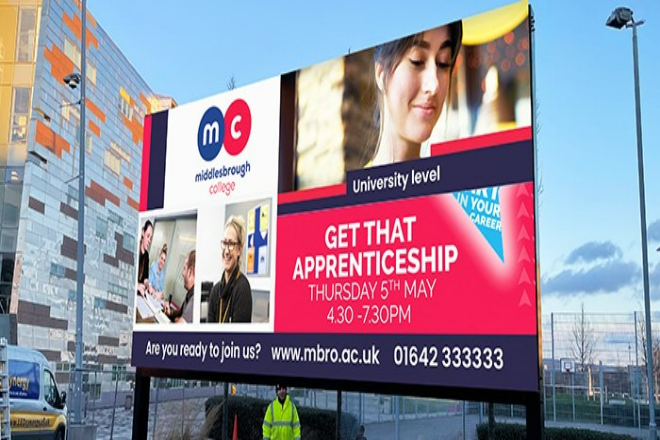序章
1. 共有 LED ディスプレイとは何ですか?
簡単に言えば、共有 LED ディスプレイとは、シェア自転車やシェアオフィススペースのように、特定の商店や機関に限定されず、複数のユーザーや組織が順番に、または同時に使用する大型スクリーンのことです。
このような共有は、コスト削減のためだけでなく、リソースを最大限に活用して情報が流通し、街をより鮮やかでカラフルにするためのものでもあります。
共有 LED ディスプレイのトレンドは今や非常に人気になっています。特にニューヨーク、ロンドン、上海などの大都市では、至る所で見かけます。専門企業が運営しているだけでなく、一部のコミュニティや学校でも、情報をより広く遠くまで広めるためにこの新しいモデルを試し始めています。
この市場がこれほど人気がある理由はいくつかあります。
- 費用対効果:
商人はスクリーン代金を支払ったり、スクリーンを維持したりすることなく広告を出稿できるため、費用と心配が省けます。スクリーン所有者にとっては、複数のユーザーがコストを分担し、収入がより安定します。
- 技術の進歩:
現在の LED ディスプレイ画面はより鮮明で明るくなり、リモート コントロールやインテリジェントな切り替えも問題なく行えます。技術の進歩により、共有は自然にスムーズになります。
2. 共有 LED ディスプレイ画面の信頼性評価フレームワークは何ですか?

共有 LED ディスプレイ スクリーンは、現在ますます人気が高まっています。しかし、ご存知ですか? これを本当に信頼できるものにするのは、それほど簡単ではありません。
技術、運用・保守、データセキュリティ、法令遵守の4つの側面から総合的に評価する必要があります。
1). 技術的な信頼性:
まず、この技術についてお話ししなければなりません。LEDディスプレイ画面は、十分な明るさ、高コントラスト、高解像度、高速でなければなりません。 リフレッシュレートこうすることで、昼でも夜でも、動いても静いても、はっきりと見ることができます。
しかし、共用の LED ディスプレイ スクリーンは異なります。長期間安定して動作し、さまざまなユーザーやコンテンツのニーズを満たす必要があります。そのため、安定性が大きな問題になります。どうすればよいでしょうか。
画面が「焼ける」のを防ぐために、高品質の LED チップとドライバ回路を選択し、放熱設計を最適化する必要があります。さらに、画面を長く使用し続けるためには、定期的なメンテナンスと手入れも不可欠です。
2). 運用と保守の信頼性:
運用とメンテナンスについて言えば、これは共用LEDディスプレイを長く使用できるかどうかの鍵です。ほこりの掃除、ラインのチェック、防水など、基本的なスキルである日常のメンテナンスをしっかりと行う必要があります。
しかし、何か問題が発生した場合はどうすればよいのでしょうか? 病院の緊急治療室のように、問題を迅速に特定して解決できる、迅速に応答する障害処理メカニズムが必要です。
今では技術が非常に進歩しており、遠隔監視やインテリジェント診断技術も役立ちます。
リモート監視システムを通じて、画面に「心電図」を設置するのと同じように、ディスプレイ画面の動作状態とパフォーマンスパラメータをリアルタイムで把握できます。インテリジェント診断技術は、予備分析を実施し、障害を特定し、保守担当者に正確な「処方箋」を提供できる「医師」のようなものです。
3) データセキュリティとプライバシー保護:
共有環境では、データのセキュリティが大きな問題となります。考えてみてください。誰かが悪意を持ってコンテンツを変更したり、ハッカーがシステムに侵入してデータを盗んだりしたら、大変なことになります。
そのため、暗号化技術を使用してデータを「装甲」し、アクセス制御メカニズムを設定してシステムを「ロック」するなど、データセキュリティ保護を強化する必要があります。また、ウイルスの侵入を防ぐためにコンピューターにワクチンを接種するのと同じように、システムとセキュリティパッチを定期的に更新する必要があります。
さらに、プライバシー保護も無視できません。ユーザーデータを収集、処理、送信する際には、プライバシー保護規制を遵守し、ユーザーの個人情報を「公開」してはなりません。
4) 法令遵守:
最後に、法令遵守についてお話しします。LED ディスプレイ画面の共有には、著作権、広告法、プライバシー権など、複数の法律や規制が関係する場合があります。注意しないと、法律に違反する可能性があります。
そのため、私たちは「ふるい」のように厳格なコンテンツ審査メカニズムを確立し、すべての非準拠コンテンツをフィルタリングする必要があります。また、パートナーとのコミュニケーションと協力を強化し、共同で市場秩序を維持する必要があります。
さらに、従業員が何ができて何ができないかを理解できるように、定期的に法令に関する研修を行うことも必要です。
一般的に、共有 LED ディスプレイ スクリーンの信頼性評価フレームワークは「4 つの壁」のようなもので、技術、運用と保守、データ セキュリティ、法令遵守が不可欠です。
これら 4 つの側面が適切に実行されて初めて、共有 LED ディスプレイ画面は真に「安定」し、ユーザーに優れた視聴体験をもたらすことができます。
3. 実際の共有LEDディスプレイのケース分析と体験のまとめ

事例1:杭州アジア競技大会の「テクノロジー名刺」
杭州アジア競技大会の会場にいて、熱狂的な観客とエキサイティングな競技に囲まれていると想像してみてください。
見上げると、巨大な LED ディスプレイ スクリーンにイベントの興奮の瞬間がリアルタイムで映し出されており、その映像は非常に鮮明で、まるでその場にいるかのようです。このスクリーンは、観客が視覚的な饗宴を楽しむことができるだけでなく、スポンサーにとっても優れた展示プラットフォームを提供します。
この共有 LED ディスプレイ プロジェクトは、まさに一石二鳥です。運営会社が保守と管理を担当し、スクリーンの安定した動作を保証します。また、タイムシェアリング方式により、さまざまなスポンサーとメディアが順番に自分のスタイルを披露することができます。
技術的には、先進的なCOB技術を採用しており、画面の明るさやコントラストは一流で、長時間観ても疲れません。市場の反応もかなり良いです。観客は観ていて楽しいと言っており、スポンサーも価値があると考えていました。

事例2:ニューヨーク・メッツの「超巨大スクリーン」
コート上の「スター」とも言えるニューヨーク・メッツの超巨大スクリーンについてお話しましょう。このスクリーンは大きいだけでなく、明るいです。夜に試合を観戦すると、まるで屋外で映画を観ているようです。
イベント情報の表示だけでなく、スポンサー企業にとっての「黄金の広告スペース」としても活用。時間を共有し、コンテンツを共有し、みんなで楽しんでいます。
技術的にも、このスクリーンはかなり素晴らしいです。超高精細な画像、切り替えは非常にスムーズです。さらに、特に耐久性があり、風雨を恐れません。このスクリーン以来、ファンの視聴体験は急上昇し、スポンサーも満面の笑みを浮かべました。
3). 直面した課題と問題:
しかし、LED ディスプレイ画面の共有は、必ずしも順風満帆というわけではありません。まず、調整と管理が大きな問題です。ユーザーや組織が多数存在するため、誰もが独自のコンテンツを使用したいと考えています。
時間の配分や利益の分配を慎重に検討する必要があります。注意しないと、衝突が発生しやすくなります。
さらに、利益の分配も頭の痛い問題です。スクリーン所有者、運営会社、コンテンツプロバイダーは皆、利益を享受しなければなりません。この「ケーキ」をどうやって分け合えば、全員が満足できるのでしょうか。
技術的なボトルネックも無視できない問題です。現在の LED ディスプレイ技術はかなり進歩していますが、改善の余地は常にあります。
たとえば、画像をより明るく鮮明にする方法や、スマートコントロールをより便利にする方法は、常に克服する必要がある技術的な問題です。
4). 経験の要約とインスピレーション:
ここまで述べてきましたが、まとめると、どのような経験から学ぶ価値があるかを見てみましょう。
まず、機器を選択する際には注意が必要です。 シェアリング成功の半分は、良い設備です。これは、技術の成熟度だけでなく、表示効果と安定性にも関係します。事故が起きたら大変なので、あまりお金をかけずに良い製品が買えると思わないでください。
第二に、運用メカニズムを確立する必要があります。 ユーザー管理、コンテンツのレビュー、トラブルシューティングには、すべて明確なプロセスと仕様が必要です。何か問題が起きたときに誰もが責任を逃れないようにしてください。それは恥ずかしいことです。
さらに、技術革新と改善も続けなければなりません。 時代は進み、技術は絶えず更新されています。共有 LED ディスプレイの競争力を維持するためには、新しい知識と新しい技術を学び続ける必要があります。
最後に、協力とコミュニケーションを強化する必要があります。 共有とは、全員が協力し合うことです。すべての関係者ともっと話し合い、彼らのニーズや意見に耳を傾ける必要があります。そうすれば、より合理的な計画を立てることができます。常に自分が最終決定権を持っていると考えないでください。そうしないと、うまくいきません。
4. シェアードLEDディスプレイの将来展望と提案

1). 技術革新:
まず、技術革新についてお話ししましょう。LED ディスプレイ技術自体は常に進歩しています。将来、これらの画面はより明るく鮮明になるだけでなく、より「スマート」になります。どの程度スマートになるのでしょうか?
道を歩いているときに、共有 LED スクリーンが見えるところを想像してみてください。高解像度の画像を表示するだけでなく、ユーザーの好みに応じてコンテンツを推奨することもできます。たとえば、映画鑑賞が好きなら、最新の映画予告編を推奨します。
スポーツが好きなら、スポーツイベントのハイライトを再生してくれます。その背後には、モノのインターネットと人工知能の功績があります。これらにより、画面にあなたを「認識」させ、パーソナライズされたサービスを提供できるようになります。
さらに、これらのスクリーンはあなたと対話することができます。携帯電話でスキャンすることで、ゲームに参加したり、投票したり、スクリーン上の他のユーザーとチャットしたりすることもできます。このインタラクティブな体験は、考えただけでもワクワクします。
2). Business model:
技術革新について話した後は、ビジネスモデルについて話しましょう。共有 LED ディスプレイ スクリーンは、広告に使用されるだけでなく、収益を得る方法も多数あります。たとえば、広告の配置をより正確かつ効率的にすることができます。
画面ではユーザーの好みに応じて広告を推奨できるため、広告主はターゲット ユーザーに広告をより正確に届けることができるため、より積極的に資金を投資するようになります。
コンテンツのカスタマイズサービスもあり、これも大きな利益をもたらします。宣伝やライブ放送活動を行いたい企業は、共有LEDディスプレイスクリーンを見つけることができます。スクリーンオペレーターは、顧客のニーズに応じてカスタマイズされたサービスを提供し、宣伝ニーズを満たすことができます。
さらに、データサービスの宝も忘れないでください。共有LEDスクリーンは大量のユーザー行動データを収集することができ、これは宝です!オペレーターはこのデータを分析し、ユーザーポートレート、広告効果評価などのサービスを提供し、広告主やパートナーに意思決定のサポートを提供できます。
もちろん、電子商取引、観光、教育などの業界と協力して付加価値サービスを提供し、収益を上げる方法を増やすなど、国境を越えた協力を模索することもできます。
3) 政策提言と業界標準:
最後に、政策勧告と業界標準についてお話しします。共有 LED スクリーン業界は急速に発展しており、政策と標準のガイダンスなしには成り立ちません。
こうした企業がより安心して研究開発やイノベーションに取り組むことができるよう、政府は財政支援や税制優遇などの支援を行う必要がある。
同時に、市場秩序を規制するためのいくつかの基準を策定する必要があります。たとえば、消費者がより安心してスクリーンを使用できるように、スクリーンの技術基準、サービス基準、安全基準を用意する必要があります。
さらに、一部の企業が不正行為をしないように監督を強化する必要があります。規制プラットフォームを確立し、資格審査と日常的な事業者の監督を行い、規制に準拠した運営を確実にします。
最後に、イノベーションを奨励し、知的財産権を保護することを忘れないでください。こうすることで、より多くの企業がイノベーションと投資に挑戦し、業界全体の発展を促進するでしょう。
結論
この記事の分析を通じて、技術の継続的な進歩、ますます成熟する運用モデル、および法律や規制の段階的な改善により、共有 LED ディスプレイ スクリーンの信頼性が徐々に向上していることがわかります。
広告主、コンテンツ制作者、会場所有者に、より柔軟で効率的な情報発信プラットフォームを提供するだけでなく、都市情報化の構築に新たな活力を注入します。
最後に、LEDディスプレイスクリーンについてさらに詳しく知りたい場合は、 ご連絡ください。

